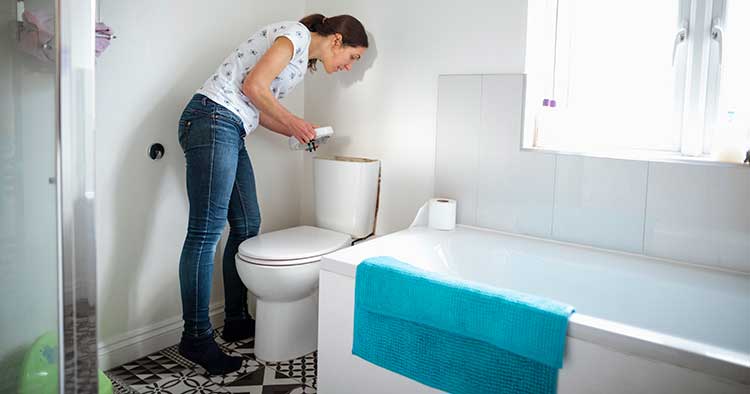HOME IMPROVEMENT
How to Fix Your Toilet: A Troubleshooting Guide

Learn how to repair toilets! This post will cover the five most common issues with toilets, and how to fix them. While some toilet problems may need to be addressed by a plumber, most are simple and easy to fix. Leaky toilets, constantly running toilets and clogged toilets are some of the most common issues. You may need to call a plumber depending on how complex your plumbing system is or how severe the problem is.
Anatomy of a Toilet
Let’s start with the basics. All toilets, regardless of whether they are post-94 low flow or older standard 3.6GPF models, have two main parts.
- Fill Valve – This valve sits in the tank and adds water to it. This valve sends water through the refill tube to the bowl.
- Flush Valve – This is made up of the flush, flapper, and tank lever, which are all connected.
Let’s solve your toilet problems! This video will show you how to use the toilet.
1. Leaking Toilet
Here’s how to find out where your toilet is leaking.
Base Leak
Important: Leakage from the base could cause serious damage to your floor. This problem must be fixed immediately!
- Start by drying the exterior surfaces with water.
- Next, add food coloring to the tank. Flush. Allow sitting for one hour.
- Use a towel to wipe the toilet base. If water is visible, it’s likely that your toilet leak has been discovered.
- You are now ready to go by replacing the wax ring and flange
2. Ghost Flushing
Definition: When the toilet flushes even though no one is present. It’s so scary! Use the same technique with food coloring to diagnose but don’t flush. Watch out for the food coloring to end up in your toilet. You have a ghost in the toilet! Just kidding!
A worn or deteriorated flapper can cause ghost flushing. This is why DROP-IN BOWL CLEANERS containing bleach tend to cause ghost flushing. Instead, you can use a regular bowl cleaner!
If your toilet is consistently blocked, you could think about investing in brand-new, high-performance smart toilets. Check with your local city office to see if there are any subsidies available for smart toilets.
Here are some ways to replace your flapper.
- Turn off the water valve, and flush until there is no more water.
- Take the flapper off the pivot arm.
- Place the new flapper on the valve seat, then click it back in place.
If you are still having problems with the flapper, it is possible that your drain seat has corroded. This can cause water to leak from your bowl and prevents you from getting a seal. This can be fixed by either a simple repair kit for the flush valve or a completely new flush valve. If this fails, contact expert plumbers to locate the cause.
3. Continuously Running the Toilet
As mentioned in the previous step, first check the flapper. Next, check that there isn’t any sediment in the area around your fill valve. This will prevent it from sealing properly. If it is, your tank water level may be too high. To compensate, water should flow into your overflow valve.
Two ways to adjust water level:
- Stainless Steel Adjustment rod – Grab the outside edges of your clip on the back of your float cup. Next, push the clip and float the cup down on the stainless-steel link.
- Plastic Screw Adjustment Rod – Simply turn the screw counterclockwise to lower the water level.
If the problem persists then your fill valve seal could be damaged. You can fix the problem by removing the cap from the top of your fill valve and replacing the seal. You can also replace the entire fill valve if you are up for it.
4. Double Flush
Definition: When your bowl flushes automatically 2 to 4 times.
- Quick fix- Your flapper may be the wrong one. Buy an adjustable flapper. You can adjust it by dialing the appropriate flush number to eliminate double flushing.
- Are you still having trouble? You might have a stuck tank lever. It’s possible that your tank lever is sticking.
You might consider purchasing new high-performance low flow toilets if your toilet is always clogged. Low flow toilets are sometimes available in rebates, so check with your local city office. It may be time to schedule a septic tank pumping.
5. Clogged Toilet
Let’s now talk about everyone’s favorite! Is it really necessary to define this one? These are some suggestions!
The right type of plunger is needed:
- Cup Plunger – Designed to be used on flat surfaces such as a bathtub.
- Flange Plunger is a toilet-specific tool. The bowl’s bottom opening is sealed to create the vacuum and pressure required to clear a clog.
If the plunger isn’t working, you can use a snake or a Plumbers Auger.
- You can avoid damaging porcelain by using a plumber’s auger with a protective cover.
- Use protective rubber gloves to scoop out water with a cup. Once the water level has dropped, dispose of it.
- Put spring in a bowl, and then work it through the drain line and trap it until it is clear. You can then just take it out, and your toilet will be unclogged!
